Deck 32: An Overview of Animal Diversity
Question
Question
Question
Question
Question
Question
Question
Question
Question
Question
Question
Question
Question
Question
Question
Question
Question
Question
Question
Question
Question
Question
Question
Question
Question
Question
Question
Question
Question
Question
Question
Question
Question
Question
Question
Question
Question
Question
Question
Question
Question
Question
Question
Question
Question
Question
Question
Question
Question
Question
Question
Question
Question
Question
Question
Question
Question
Question
Question
Question
Question
Question
Question
Question
Question
Question
Question

Unlock Deck
Sign up to unlock the cards in this deck!
Unlock Deck
Unlock Deck
1/67
Play
Full screen (f)
Deck 32: An Overview of Animal Diversity
1
What do animals ranging from corals to monkeys have in common?
A) a mouth and an anus
B) number of embryonic tissue layers
C) some type of body symmetry
D) presence of Hox genes
A) a mouth and an anus
B) number of embryonic tissue layers
C) some type of body symmetry
D) presence of Hox genes
D
2
Arthropods invaded land about 100 million years before vertebrates. This fact most clearly implies that ________.
A) arthropods evolved before vertebrates did
B) extant terrestrial arthropods are better adapted to terrestrial life than are extant terrestrial vertebrates
C) vertebrates evolved from arthropods
D) arthropods have had more time to coevolve with land plants than have vertebrates
A) arthropods evolved before vertebrates did
B) extant terrestrial arthropods are better adapted to terrestrial life than are extant terrestrial vertebrates
C) vertebrates evolved from arthropods
D) arthropods have had more time to coevolve with land plants than have vertebrates
D
3
Which of the following is (are) unique to animals?
A) the structural carbohydrate, chitin
B) nervous system signal conduction and muscular movement
C) heterotrophy
D) flagellated gametes
A) the structural carbohydrate, chitin
B) nervous system signal conduction and muscular movement
C) heterotrophy
D) flagellated gametes
B
4
Use the information to answer the question.
Trichoplax adhaerens is the only living species in the phylum Placozoa. Individuals are about 1 mm wide and only 27 µm high, are irregularly shaped, and consist of a total of about 2,000 cells, which are diploid (2n = 12). There are four types of cells, none of which are nerve or muscle cells, and none of which have cell walls. Individual animals move using cilia, and any "edge" can lead. T. adhaerens feeds on marine microbes, mostly unicellular green algae, by crawling atop the algae and trapping it between its ventral surface and the substrate. Enzymes are then secreted onto the algae, and the resulting nutrients are absorbed. T. adhaerens sperm cells have never been observed, nor have embryos past the 64-cell (blastula) stage.
Which of the following T. adhaerens traits is different from all other known animals?
A) T. adhaerens is multicellular.
B) T. adhaerens lacks muscle and nerve cells.
C) T. adhaerens has cilia.
D) T. adhaerens lacks cell walls.
Trichoplax adhaerens is the only living species in the phylum Placozoa. Individuals are about 1 mm wide and only 27 µm high, are irregularly shaped, and consist of a total of about 2,000 cells, which are diploid (2n = 12). There are four types of cells, none of which are nerve or muscle cells, and none of which have cell walls. Individual animals move using cilia, and any "edge" can lead. T. adhaerens feeds on marine microbes, mostly unicellular green algae, by crawling atop the algae and trapping it between its ventral surface and the substrate. Enzymes are then secreted onto the algae, and the resulting nutrients are absorbed. T. adhaerens sperm cells have never been observed, nor have embryos past the 64-cell (blastula) stage.
Which of the following T. adhaerens traits is different from all other known animals?
A) T. adhaerens is multicellular.
B) T. adhaerens lacks muscle and nerve cells.
C) T. adhaerens has cilia.
D) T. adhaerens lacks cell walls.

Unlock Deck
Unlock for access to all 67 flashcards in this deck.
Unlock Deck
k this deck
5
Which of the following genetic processes may be most helpful in accounting for the Cambrian explosion?
A) binary fission
B) random segregation
C) gene duplication
D) chromosomal condensation
A) binary fission
B) random segregation
C) gene duplication
D) chromosomal condensation

Unlock Deck
Unlock for access to all 67 flashcards in this deck.
Unlock Deck
k this deck
6
Use the table to answer the following question.
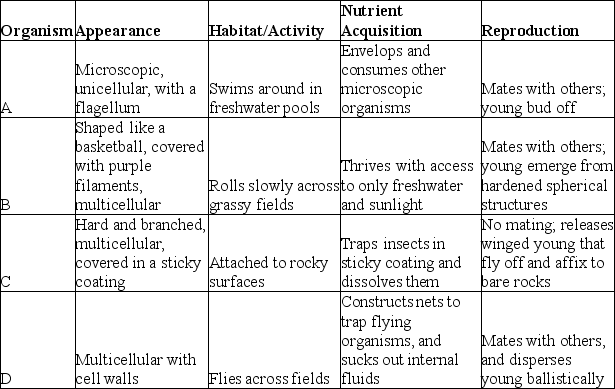
As you are on the way to Tahiti for a vacation, your plane crash lands on a previously undiscovered island. You soon find that the island is teeming with unfamiliar organisms, and you, as a student of biology, decide to survey them (with the aid of the Insta-Lab Portable Laboratory you brought along in your suitcase). You select four organisms and observe them in detail, making the notations found in the figure.
In which of the organisms listed would you search for collagen?
A) organism A
B) organism B
C) organism C
D) organism D

As you are on the way to Tahiti for a vacation, your plane crash lands on a previously undiscovered island. You soon find that the island is teeming with unfamiliar organisms, and you, as a student of biology, decide to survey them (with the aid of the Insta-Lab Portable Laboratory you brought along in your suitcase). You select four organisms and observe them in detail, making the notations found in the figure.
In which of the organisms listed would you search for collagen?
A) organism A
B) organism B
C) organism C
D) organism D

Unlock Deck
Unlock for access to all 67 flashcards in this deck.
Unlock Deck
k this deck
7
Cadherin proteins help animal cells stick (adhere) to each other. Choose which statement about cadherin in cancer cells that are metastasizing (spreading) throughout a patient's body is most likely correct.
A) Cadherin proteins in metastasizing cancer cells are likely to have mutations that make them less "sticky."
B) Cadherin proteins in metastasizing cancer cells are likely to have mutations that make them more "sticky."
C) Mutations in cadherin proteins are unlikely to affect the metastasizing of cancer cells.
D) Mutations in cadherin proteins accumulate at a constant rate that can be measured by a molecular clock.
A) Cadherin proteins in metastasizing cancer cells are likely to have mutations that make them less "sticky."
B) Cadherin proteins in metastasizing cancer cells are likely to have mutations that make them more "sticky."
C) Mutations in cadherin proteins are unlikely to affect the metastasizing of cancer cells.
D) Mutations in cadherin proteins accumulate at a constant rate that can be measured by a molecular clock.

Unlock Deck
Unlock for access to all 67 flashcards in this deck.
Unlock Deck
k this deck
8
Evidence of which structure or characteristic would be most surprising to find among fossils of the Ediacaran fauna?
A) true tissues
B) hard parts
C) bilateral symmetry
D) embryos
A) true tissues
B) hard parts
C) bilateral symmetry
D) embryos

Unlock Deck
Unlock for access to all 67 flashcards in this deck.
Unlock Deck
k this deck
9
Use the table to answer the following question.
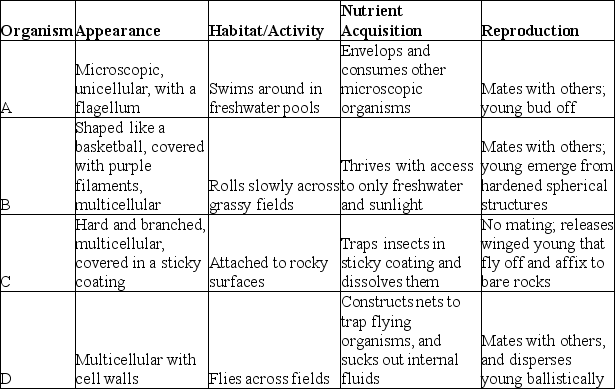
As you are on the way to Tahiti for a vacation, your plane crash lands on a previously undiscovered island. You soon find that the island is teeming with unfamiliar organisms, and you, as a student of biology, decide to survey them (with the aid of the Insta-Lab Portable Laboratory you brought along in your suitcase). You select four organisms and observe them in detail, making the notations found in the figure.
Which organism would you classify as an animal?
A) organism A
B) organism B
C) organism C
D) organism D

As you are on the way to Tahiti for a vacation, your plane crash lands on a previously undiscovered island. You soon find that the island is teeming with unfamiliar organisms, and you, as a student of biology, decide to survey them (with the aid of the Insta-Lab Portable Laboratory you brought along in your suitcase). You select four organisms and observe them in detail, making the notations found in the figure.
Which organism would you classify as an animal?
A) organism A
B) organism B
C) organism C
D) organism D

Unlock Deck
Unlock for access to all 67 flashcards in this deck.
Unlock Deck
k this deck
10
The larvae of some insects are merely small versions of the adult, whereas the larvae of other insects look completely different from adults, eat different foods, and may live in different habitats. Which of the following is most directly involved in the evolution of these variations in metamorphosis?
A) artificial selection of sexually immature forms of insects
B) changes in the homeobox genes controlling early development
C) the evolution of meiosis
D) the origin of a brain
A) artificial selection of sexually immature forms of insects
B) changes in the homeobox genes controlling early development
C) the evolution of meiosis
D) the origin of a brain

Unlock Deck
Unlock for access to all 67 flashcards in this deck.
Unlock Deck
k this deck
11
The evolution of animal species has been prolific (current estimates of species numbers reach into the tens of millions). Much of this diversity is a result of the evolution of novel ways to ________.
A) reproduce
B) arrange cells into tissues
C) sense, feed, and move
D) form an embryo and establish a basic body plan
A) reproduce
B) arrange cells into tissues
C) sense, feed, and move
D) form an embryo and establish a basic body plan

Unlock Deck
Unlock for access to all 67 flashcards in this deck.
Unlock Deck
k this deck
12
In individual insects of some species, whole chromosomes that carry larval genes are eliminated from the genomes of somatic cells at the time of metamorphosis. A consequence of this occurrence is that ________.
A) we could not clone a larva from the somatic cells of such an adult insect
B) such species must reproduce only asexually
C) the descendants of these adults do not include a larval stage
D) metamorphosis can no longer occur among the descendants of such adults
A) we could not clone a larva from the somatic cells of such an adult insect
B) such species must reproduce only asexually
C) the descendants of these adults do not include a larval stage
D) metamorphosis can no longer occur among the descendants of such adults

Unlock Deck
Unlock for access to all 67 flashcards in this deck.
Unlock Deck
k this deck
13
Both animals and fungi are heterotrophic. What distinguishes animal heterotrophy from fungal heterotrophy is that most animals derive their nutrition by ________.
A) preying on animals
B) ingesting materials
C) consuming living, rather than dead, prey
D) using enzymes to digest their food
A) preying on animals
B) ingesting materials
C) consuming living, rather than dead, prey
D) using enzymes to digest their food

Unlock Deck
Unlock for access to all 67 flashcards in this deck.
Unlock Deck
k this deck
14
Whatever its ultimate cause(s), the Cambrian explosion is a prime example of ________.
A) mass extinction
B) evolutionary stasis
C) adaptive radiation
D) a large meteor impact
A) mass extinction
B) evolutionary stasis
C) adaptive radiation
D) a large meteor impact

Unlock Deck
Unlock for access to all 67 flashcards in this deck.
Unlock Deck
k this deck
15
Which of the following would you classify as something other than an animal?
A) sponge
B) coral
C) jellyfish
D) choanoflagellate
A) sponge
B) coral
C) jellyfish
D) choanoflagellate

Unlock Deck
Unlock for access to all 67 flashcards in this deck.
Unlock Deck
k this deck
16
A researcher is trying to construct a molecular-based phylogeny of the entire animal kingdom. Assuming that none of the following genes are absolutely conserved, which of the following would be the best choice on which to base the phylogeny?
A) genes involved in chitin synthesis
B) collagen genes
C) genes involved in directing segmentation development
D) genes involved in eye-lens synthesis
A) genes involved in chitin synthesis
B) collagen genes
C) genes involved in directing segmentation development
D) genes involved in eye-lens synthesis

Unlock Deck
Unlock for access to all 67 flashcards in this deck.
Unlock Deck
k this deck
17
One hypothesis suggests that the Cambrian explosion was caused by the rise of predator-prey relationships. This hypothesis is best supported by an increased incidence of which of the following fossil traces?
A) worm burrows
B) larger animals
C) organic material
D) hard parts
A) worm burrows
B) larger animals
C) organic material
D) hard parts

Unlock Deck
Unlock for access to all 67 flashcards in this deck.
Unlock Deck
k this deck
18
The last common ancestor of all animals was probably a ________.
A) unicellular chytrid
B) multicellular algae
C) multicellular fungus
D) flagellated protist
A) unicellular chytrid
B) multicellular algae
C) multicellular fungus
D) flagellated protist

Unlock Deck
Unlock for access to all 67 flashcards in this deck.
Unlock Deck
k this deck
19
Use the table to answer the following question.
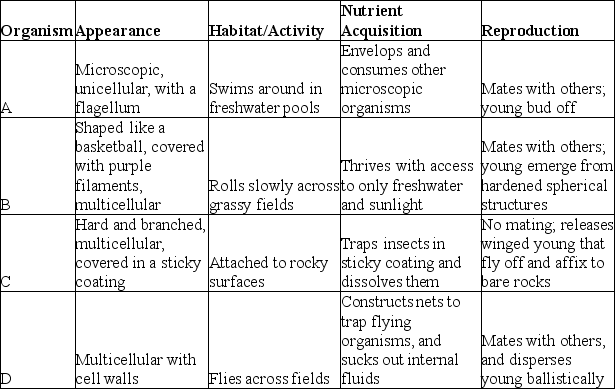
As you are on the way to Tahiti for a vacation, your plane crash lands on a previously undiscovered island. You soon find that the island is teeming with unfamiliar organisms, and you, as a student of biology, decide to survey them (with the aid of the Insta-Lab Portable Laboratory you brought along in your suitcase). You select four organisms and observe them in detail, making the notations found in the figure.
In which of the organisms listed would you search for photosynthetic genes?
A) organism A
B) organism B
C) organism C
D) organism D

As you are on the way to Tahiti for a vacation, your plane crash lands on a previously undiscovered island. You soon find that the island is teeming with unfamiliar organisms, and you, as a student of biology, decide to survey them (with the aid of the Insta-Lab Portable Laboratory you brought along in your suitcase). You select four organisms and observe them in detail, making the notations found in the figure.
In which of the organisms listed would you search for photosynthetic genes?
A) organism A
B) organism B
C) organism C
D) organism D

Unlock Deck
Unlock for access to all 67 flashcards in this deck.
Unlock Deck
k this deck
20
The fact that choanoflagellates and collar cells of sponges resemble each other supports the inference that ________.
A) choanoflagellates are animals
B) choanoflagellates are more closely related to sponges than they are to protists
C) choanoflagellates and sponges are sister groups
D) choanoflagellates and sponges evolved similar cell structures through convergent evolution
A) choanoflagellates are animals
B) choanoflagellates are more closely related to sponges than they are to protists
C) choanoflagellates and sponges are sister groups
D) choanoflagellates and sponges evolved similar cell structures through convergent evolution

Unlock Deck
Unlock for access to all 67 flashcards in this deck.
Unlock Deck
k this deck
21
Among protostomes, which morphological trait has shown the most variation?
A) type of symmetry (bilateral versus radial versus none)
B) type of body cavity (coelom versus pseudocoelom versus no coelom)
C) number of embryonic tissue types (diploblasty versus triploblasty)
D) type of development (protostome versus deuterostome)
A) type of symmetry (bilateral versus radial versus none)
B) type of body cavity (coelom versus pseudocoelom versus no coelom)
C) number of embryonic tissue types (diploblasty versus triploblasty)
D) type of development (protostome versus deuterostome)

Unlock Deck
Unlock for access to all 67 flashcards in this deck.
Unlock Deck
k this deck
22
Use the information to answer the question.
Trichoplax adhaerens is the only living species in the phylum Placozoa. Individuals are about 1 mm wide and only 27 μm high, are irregularly shaped, and consist of a total of about 2,000 cells, which are diploid (2n = 12). There are four types of cells, none of which are nerve or muscle cells, and none of which have cell walls. Individual animals move using cilia, and any "edge" can lead. T. adhaerens feeds on marine microbes, mostly unicellular green algae, by crawling atop the algae and trapping it between its ventral surface and the substrate. Enzymes are then secreted onto the algae, and the resulting nutrients are absorbed. T. adhaerens sperm cells have never been observed, nor have embryos past the 64-cell (blastula) stage.
T) adhaerens' body symmetry seems to be most like that of ________.
A) most sponges
B) cnidarians
C) worms
D) tetrapods
Trichoplax adhaerens is the only living species in the phylum Placozoa. Individuals are about 1 mm wide and only 27 μm high, are irregularly shaped, and consist of a total of about 2,000 cells, which are diploid (2n = 12). There are four types of cells, none of which are nerve or muscle cells, and none of which have cell walls. Individual animals move using cilia, and any "edge" can lead. T. adhaerens feeds on marine microbes, mostly unicellular green algae, by crawling atop the algae and trapping it between its ventral surface and the substrate. Enzymes are then secreted onto the algae, and the resulting nutrients are absorbed. T. adhaerens sperm cells have never been observed, nor have embryos past the 64-cell (blastula) stage.
T) adhaerens' body symmetry seems to be most like that of ________.
A) most sponges
B) cnidarians
C) worms
D) tetrapods

Unlock Deck
Unlock for access to all 67 flashcards in this deck.
Unlock Deck
k this deck
23
A student encounters an animal embryo at the eight-cell stage. The four smaller cells that comprise 1 hemisphere of the embryo seem to be rotated 45° and to lie in the grooves between larger, underlying cells. If we were to separate these eight cells and attempt to culture them individually, then what is most likely to happen?
A) All eight cells will die immediately.
B) Each cell may continue development, but only into a nonviable embryo that lacks many parts.
C) Each cell may develop into a full-sized, normal embryo.
D) Each cell may develop into a smaller-than-average, but otherwise normal, embryo.
A) All eight cells will die immediately.
B) Each cell may continue development, but only into a nonviable embryo that lacks many parts.
C) Each cell may develop into a full-sized, normal embryo.
D) Each cell may develop into a smaller-than-average, but otherwise normal, embryo.

Unlock Deck
Unlock for access to all 67 flashcards in this deck.
Unlock Deck
k this deck
24
What was an early selective advantage of a coelom in animals? A coelom ________.
A) contributed to a hydrostatic skeleton, allowing greater range of motion
B) was a more efficient digestive system
C) allowed cephalization and the formation of a cerebral ganglion
D) allowed asexual and sexual reproduction
A) contributed to a hydrostatic skeleton, allowing greater range of motion
B) was a more efficient digestive system
C) allowed cephalization and the formation of a cerebral ganglion
D) allowed asexual and sexual reproduction

Unlock Deck
Unlock for access to all 67 flashcards in this deck.
Unlock Deck
k this deck
25
What do all deuterostomes have in common?
A) Adults are bilaterally symmetrical.
B) Embryos have pharyngeal pouches that may or may not form gill slits.
C) All have a spinal column.
D) The pore (blastopore) formed during gastrulation becomes the anus.
A) Adults are bilaterally symmetrical.
B) Embryos have pharyngeal pouches that may or may not form gill slits.
C) All have a spinal column.
D) The pore (blastopore) formed during gastrulation becomes the anus.

Unlock Deck
Unlock for access to all 67 flashcards in this deck.
Unlock Deck
k this deck
26
While looking at some seawater through your microscope, you spot the egg of an unknown animal. Which of the following tests could you use to determine whether the developing organism is a protostome or a deuterostome? See whether the embryo ________.
A) develops germ layers
B) exhibits spiral cleavage or radial cleavage
C) develops a blastopore
D) develops an archenteron
A) develops germ layers
B) exhibits spiral cleavage or radial cleavage
C) develops a blastopore
D) develops an archenteron

Unlock Deck
Unlock for access to all 67 flashcards in this deck.
Unlock Deck
k this deck
27
A student encounters an animal embryo at the eight-cell stage. The four smaller cells that comprise 1 hemisphere of the embryo seem to be rotated 45° and to lie in the grooves between larger, underlying cells. This embryo may potentially develop into a(n) ________.
A) turtle
B) earthworm
C) sea star
D) sea urchin
A) turtle
B) earthworm
C) sea star
D) sea urchin

Unlock Deck
Unlock for access to all 67 flashcards in this deck.
Unlock Deck
k this deck
28
An organism that exhibits a head with sensory equipment and a brain probably also ________.
A) is bilaterally symmetrical
B) has a coelom
C) is segmented
D) is diploblastic
A) is bilaterally symmetrical
B) has a coelom
C) is segmented
D) is diploblastic

Unlock Deck
Unlock for access to all 67 flashcards in this deck.
Unlock Deck
k this deck
29
Which tissue type or organ is not correctly matched with its germ layer tissue?
A) nervous-mesoderm
B) muscular-mesoderm
C) stomach-endoderm
D) skin-ectoderm
A) nervous-mesoderm
B) muscular-mesoderm
C) stomach-endoderm
D) skin-ectoderm

Unlock Deck
Unlock for access to all 67 flashcards in this deck.
Unlock Deck
k this deck
30
Use the information to answer the question.
Nudibranchs, a type of predatory sea slug, can have various protuberances (that is, extensions) on their dorsal surfaces. Rhinophores are paired structures, located close to the head, which bear many chemoreceptors. Dorsal plumules, usually located posteriorly, perform respiratory gas exchange. Cerata usually cover much of the dorsal surface and contain nematocysts at their tips.
If nudibranch rhinophores are located at the anterior ends of these sea slugs, then they contribute to the sea slugs' ________.
A) segmentation
B) lack of torsion
C) development of a head
D) identity as lophotrochozoans
Nudibranchs, a type of predatory sea slug, can have various protuberances (that is, extensions) on their dorsal surfaces. Rhinophores are paired structures, located close to the head, which bear many chemoreceptors. Dorsal plumules, usually located posteriorly, perform respiratory gas exchange. Cerata usually cover much of the dorsal surface and contain nematocysts at their tips.
If nudibranch rhinophores are located at the anterior ends of these sea slugs, then they contribute to the sea slugs' ________.
A) segmentation
B) lack of torsion
C) development of a head
D) identity as lophotrochozoans

Unlock Deck
Unlock for access to all 67 flashcards in this deck.
Unlock Deck
k this deck
31
Suppose a researcher for a pest-control company developed a chemical that inhibited the development of an embryonic mosquito's endodermal cells. Which of the following would be a likely mechanism by which this pesticide works?
A) The mosquito would develop a weakened exoskeleton that would make it vulnerable to trauma.
B) The mosquito would have trouble digesting food, due to impaired gut function.
C) The mosquito would have trouble with respiration and circulation, due to impaired muscle function.
D) The mosquito wouldn't be affected at all.
A) The mosquito would develop a weakened exoskeleton that would make it vulnerable to trauma.
B) The mosquito would have trouble digesting food, due to impaired gut function.
C) The mosquito would have trouble with respiration and circulation, due to impaired muscle function.
D) The mosquito wouldn't be affected at all.

Unlock Deck
Unlock for access to all 67 flashcards in this deck.
Unlock Deck
k this deck
32
You have before you a living organism, which you examine carefully. Which of the following should convince you that the organism is acoelomate?
A) It is triploblastic.
B) It has bilateral symmetry.
C) It possesses sensory structures at its anterior end.
D) Muscular activity of its digestive system distorts the body wall.
A) It is triploblastic.
B) It has bilateral symmetry.
C) It possesses sensory structures at its anterior end.
D) Muscular activity of its digestive system distorts the body wall.

Unlock Deck
Unlock for access to all 67 flashcards in this deck.
Unlock Deck
k this deck
33
Soon after the coelom begins to form, a researcher injects a dye into the coelom of a deuterostome embryo. Initially, the dye should be able to flow directly into the ________.
A) blastopore
B) blastocoel
C) archenteron
D) pseudocoelom
A) blastopore
B) blastocoel
C) archenteron
D) pseudocoelom

Unlock Deck
Unlock for access to all 67 flashcards in this deck.
Unlock Deck
k this deck
34
Use the information to answer the question.
One small animal phylum (Placozoa) contains only two species, Trichoplax adhaerens (T. adhaerens) and T. reptans. T. adhaerens is the only species seen in over a century. Individuals are about 1 mm wide and only 27 μm high, are irregularly shaped, and consist of a total of about 2,000 cells, which are diploid (2n = 12). There are four types of cells, none of which are nerve or muscle cells, and none of which have cell walls. Individual animals move using cilia, and any "edge" can lead. T. adhaerens feeds on marine microbes, mostly unicellular green algae, by crawling atop the algae and trapping it between its ventral surface and the substrate. Enzymes are then secreted onto the algae, and the resulting nutrients are absorbed. T. adhaerens sperm cells have never been observed. Embryos up to, but not past, the 64-cell (blastula) stage have been observed.
On the basis of information in the paragraph, which of these should be able to be observed in T. adhaerens?
A) a coelom
B) the process of gastrulation
C) eggs
D) a radially symmetric larval form
One small animal phylum (Placozoa) contains only two species, Trichoplax adhaerens (T. adhaerens) and T. reptans. T. adhaerens is the only species seen in over a century. Individuals are about 1 mm wide and only 27 μm high, are irregularly shaped, and consist of a total of about 2,000 cells, which are diploid (2n = 12). There are four types of cells, none of which are nerve or muscle cells, and none of which have cell walls. Individual animals move using cilia, and any "edge" can lead. T. adhaerens feeds on marine microbes, mostly unicellular green algae, by crawling atop the algae and trapping it between its ventral surface and the substrate. Enzymes are then secreted onto the algae, and the resulting nutrients are absorbed. T. adhaerens sperm cells have never been observed. Embryos up to, but not past, the 64-cell (blastula) stage have been observed.
On the basis of information in the paragraph, which of these should be able to be observed in T. adhaerens?
A) a coelom
B) the process of gastrulation
C) eggs
D) a radially symmetric larval form

Unlock Deck
Unlock for access to all 67 flashcards in this deck.
Unlock Deck
k this deck
35
Which of the following is a feature of the "tube-within-a-tube" body plan in most animal phyla?
A) The outer tube consists of a hard exoskeleton.
B) The outer tube consists of digestive organs.
C) The mouth and anus form the ends of the inner tube.
D) The two "tubes" are separated by tissue that comes from embryonic endoderm.
A) The outer tube consists of a hard exoskeleton.
B) The outer tube consists of digestive organs.
C) The mouth and anus form the ends of the inner tube.
D) The two "tubes" are separated by tissue that comes from embryonic endoderm.

Unlock Deck
Unlock for access to all 67 flashcards in this deck.
Unlock Deck
k this deck
36
Which of the following factors most likely contributed to the extinction of many Ediacaran life forms?
A) predation by new species, poisoning from high carbon dioxide levels, and loss of developmental flexibility
B) predation by new species, poisoning from high oxygen levels, and loss of habitat due to increased temperatures
C) predation by new species, faster movement by new species, and increased developmental flexibility by new species
D) loss of habitat due to increased temperatures, poisoning from high oxygen levels, and loss of developmental flexibility
A) predation by new species, poisoning from high carbon dioxide levels, and loss of developmental flexibility
B) predation by new species, poisoning from high oxygen levels, and loss of habitat due to increased temperatures
C) predation by new species, faster movement by new species, and increased developmental flexibility by new species
D) loss of habitat due to increased temperatures, poisoning from high oxygen levels, and loss of developmental flexibility

Unlock Deck
Unlock for access to all 67 flashcards in this deck.
Unlock Deck
k this deck
37
In examining an unknown animal species during its embryonic development, how can you be sure what you are looking at is a protostome and not a deuterostome?
A) There is evidence of cephalization.
B) The animal is triploblastic.
C) The animal is clearly bilaterally symmetrical.
D) You see a mouth, but not an anus.
A) There is evidence of cephalization.
B) The animal is triploblastic.
C) The animal is clearly bilaterally symmetrical.
D) You see a mouth, but not an anus.

Unlock Deck
Unlock for access to all 67 flashcards in this deck.
Unlock Deck
k this deck
38
The protostome developmental sequence arose just once in evolutionary history, resulting in two main subgroups-Lophotrochozoa and Ecdysozoa. What does this finding suggest?
A) These two subgroups have a common ancestor that was a deuterostome.
B) The protostomes are a polyphyletic group.
C) Division of these two groups occurred after the protostome developmental sequence appeared.
D) The lophotrochozoans are monophyletic.
A) These two subgroups have a common ancestor that was a deuterostome.
B) The protostomes are a polyphyletic group.
C) Division of these two groups occurred after the protostome developmental sequence appeared.
D) The lophotrochozoans are monophyletic.

Unlock Deck
Unlock for access to all 67 flashcards in this deck.
Unlock Deck
k this deck
39
If you think of the earthworm body plan as a drinking straw within a pipe, where would you expect to find most of the tissues that developed from endoderm?
A) lining the straw
B) lining the space between the pipe and the straw
C) forming the outside of the pipe
D) forming the outside of the straw
A) lining the straw
B) lining the space between the pipe and the straw
C) forming the outside of the pipe
D) forming the outside of the straw

Unlock Deck
Unlock for access to all 67 flashcards in this deck.
Unlock Deck
k this deck
40
Which of these statements, if accurate, would support the claim that the ancestral cnidarians had bilateral symmetry?
A) Cnidarian larvae possess anterior-posterior, left-right, and dorsal-ventral aspects.
B) Cnidarians have fewer Hox genes than bilaterians.
C) All cnidarians are acoelomate.
D) The presence of collar cells.
A) Cnidarian larvae possess anterior-posterior, left-right, and dorsal-ventral aspects.
B) Cnidarians have fewer Hox genes than bilaterians.
C) All cnidarians are acoelomate.
D) The presence of collar cells.

Unlock Deck
Unlock for access to all 67 flashcards in this deck.
Unlock Deck
k this deck
41
What is the probable sequence in which the following animal clades originated, from earliest to most recent?
A) bilaterians, deuterostomes, vertebrates, tetrapods, amniotes
B) bilaterians, deuterostomes, amniotes, vertebrates, tetrapods
C) deuterostomes, bilaterians, amniotes, vertebrates, tetrapods
D) deuterostomes, bilaterians, vertebrates, tetrapods, amniotes
A) bilaterians, deuterostomes, vertebrates, tetrapods, amniotes
B) bilaterians, deuterostomes, amniotes, vertebrates, tetrapods
C) deuterostomes, bilaterians, amniotes, vertebrates, tetrapods
D) deuterostomes, bilaterians, vertebrates, tetrapods, amniotes

Unlock Deck
Unlock for access to all 67 flashcards in this deck.
Unlock Deck
k this deck
42
Which of the following statements concerning animal taxonomy is accurate?
A) Animals are thought to have evolved from flagellated protists similar to modern choanoflagellates.
B) Kingdom Animalia is polyphyletic.
C) Animals are more closely related to plants than to fungi.
D) In the kingdom Animalia, most clades based on body plan or fossils have been found to be incorrect.
A) Animals are thought to have evolved from flagellated protists similar to modern choanoflagellates.
B) Kingdom Animalia is polyphyletic.
C) Animals are more closely related to plants than to fungi.
D) In the kingdom Animalia, most clades based on body plan or fossils have been found to be incorrect.

Unlock Deck
Unlock for access to all 67 flashcards in this deck.
Unlock Deck
k this deck
43
The primary difference between a coelom and a pseudocoelom is ________.
A) their developmental origin
B) the manner in which they cushion the internal organs
C) a coelom arises in the ectoderm, and a pseudocoelom arises in the endoderm
D) a coelom occurs in triploblastic animals, and a pseudocoelom occurs in diploblastic animals
A) their developmental origin
B) the manner in which they cushion the internal organs
C) a coelom arises in the ectoderm, and a pseudocoelom arises in the endoderm
D) a coelom occurs in triploblastic animals, and a pseudocoelom occurs in diploblastic animals

Unlock Deck
Unlock for access to all 67 flashcards in this deck.
Unlock Deck
k this deck
44
Some researchers claim that sponge genomes have homeotic genes, but no Hox genes. If true, this finding would ________.
A) mean that sponges must no longer be classified as animals
B) confirm the identity of sponges as "basal animals"
C) mean that extinct sponges must have been the last common ancestor of animals and fungi
D) require sponges to be reclassified as choanoflagellates
A) mean that sponges must no longer be classified as animals
B) confirm the identity of sponges as "basal animals"
C) mean that extinct sponges must have been the last common ancestor of animals and fungi
D) require sponges to be reclassified as choanoflagellates

Unlock Deck
Unlock for access to all 67 flashcards in this deck.
Unlock Deck
k this deck
45
Use the figure to answer the question.
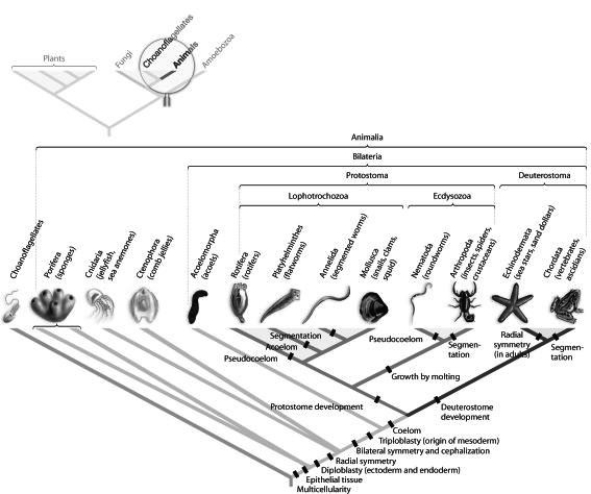
Which of the following pairs of animals show that animals with widely different adult features can be each other's closest relatives?
A) Annelida and Nematoda
B) Chordata and Echinodermata
C) Cnidemia and Ctenophora
D) Annelida and Rotifera

Which of the following pairs of animals show that animals with widely different adult features can be each other's closest relatives?
A) Annelida and Nematoda
B) Chordata and Echinodermata
C) Cnidemia and Ctenophora
D) Annelida and Rotifera

Unlock Deck
Unlock for access to all 67 flashcards in this deck.
Unlock Deck
k this deck
46
At one time, sponges were lumped into one phylum. Then, they were separated into several different phyla. Now, they are considered one phylum again. These changes indicate which of the following?
A) Every phylogeny should be considered a hypothesis that must be revised in the light of new data.
B) We need more fossil evidence of sponges.
C) Molecular and morphological data often conflict when we try to reconstruct evolutionary history.
D) The goal of making all taxonomic groups monophyletic is unrealistic.
A) Every phylogeny should be considered a hypothesis that must be revised in the light of new data.
B) We need more fossil evidence of sponges.
C) Molecular and morphological data often conflict when we try to reconstruct evolutionary history.
D) The goal of making all taxonomic groups monophyletic is unrealistic.

Unlock Deck
Unlock for access to all 67 flashcards in this deck.
Unlock Deck
k this deck
47
If in the future the current molecular evidence regarding animal origins is further substantiated, which of the following statements would be correct with reference to fossil evidence that contradicts molecular evidence?
A) The contrary fossil evidence will be seen as a hoax.
B) The fossil evidence will be understood to have been interpreted incorrectly because it is incomplete.
C) The fossil record will, henceforth, be ignored.
D) Phylogenies involving even the smallest bit of fossil evidence will need to be discarded.
A) The contrary fossil evidence will be seen as a hoax.
B) The fossil evidence will be understood to have been interpreted incorrectly because it is incomplete.
C) The fossil record will, henceforth, be ignored.
D) Phylogenies involving even the smallest bit of fossil evidence will need to be discarded.

Unlock Deck
Unlock for access to all 67 flashcards in this deck.
Unlock Deck
k this deck
48
The most ancient branch point in animal phylogeny is the characteristic of having ________.
A) radial or bilateral symmetry
B) diploblastic or triploblastic embryos
C) true tissues or no tissues
D) a body cavity or no body cavity
A) radial or bilateral symmetry
B) diploblastic or triploblastic embryos
C) true tissues or no tissues
D) a body cavity or no body cavity

Unlock Deck
Unlock for access to all 67 flashcards in this deck.
Unlock Deck
k this deck
49
Which of the following statements comparing symmetry in sessile and swimming animals is most probable?
A) Radial symmetry is more advantageous for active swimming than is bilateral symmetry.
B) Radial symmetry occurs most frequently in animals that catch their prey by rapid swimming.
C) Bilateral symmetry allowed animals to evolve nerves.
D) Bilaterally symmetric animals can be streamlined for swimming, but radially symmetric animals cannot.
A) Radial symmetry is more advantageous for active swimming than is bilateral symmetry.
B) Radial symmetry occurs most frequently in animals that catch their prey by rapid swimming.
C) Bilateral symmetry allowed animals to evolve nerves.
D) Bilaterally symmetric animals can be streamlined for swimming, but radially symmetric animals cannot.

Unlock Deck
Unlock for access to all 67 flashcards in this deck.
Unlock Deck
k this deck
50
Why might researchers choose to use molecular data (such as ribosomal RNA sequences) rather than morphological data to study the evolutionary history of animals?
A) Molecular data can be gathered in the lab, while morphological data must be gathered in the field.
B) Molecular data can be used to give an estimate of the time since two groups split.
C) Morphological changes usually do not result from molecular changes.
D) Some phyla vary too widely in morphological characteristics to be classified accurately.
A) Molecular data can be gathered in the lab, while morphological data must be gathered in the field.
B) Molecular data can be used to give an estimate of the time since two groups split.
C) Morphological changes usually do not result from molecular changes.
D) Some phyla vary too widely in morphological characteristics to be classified accurately.

Unlock Deck
Unlock for access to all 67 flashcards in this deck.
Unlock Deck
k this deck
51
You find a new species of worm and want to classify it. Which of the following lines of evidence would allow you to classify the worm as a nematode and not an annelid?
A) It is segmented.
B) It is triploblastic.
C) It has a coelom.
D) It sheds its external skeleton to grow.
A) It is segmented.
B) It is triploblastic.
C) It has a coelom.
D) It sheds its external skeleton to grow.

Unlock Deck
Unlock for access to all 67 flashcards in this deck.
Unlock Deck
k this deck
52
The common ancestor of the protostomes had a coelom. What does this suggest?
A) All lophotrochozoans have a coelom.
B) There are no pseudocoelomates within the protostomes.
C) There are no acoelomates within the protostomes.
D) The body cavity evolved before the lophophore.
A) All lophotrochozoans have a coelom.
B) There are no pseudocoelomates within the protostomes.
C) There are no acoelomates within the protostomes.
D) The body cavity evolved before the lophophore.

Unlock Deck
Unlock for access to all 67 flashcards in this deck.
Unlock Deck
k this deck
53
Use the figure to answer the question.
A: Morphological phylogeny.
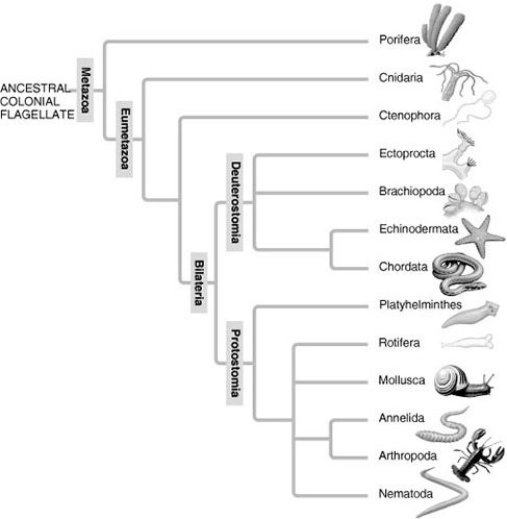
B: Molecular phylogeny.
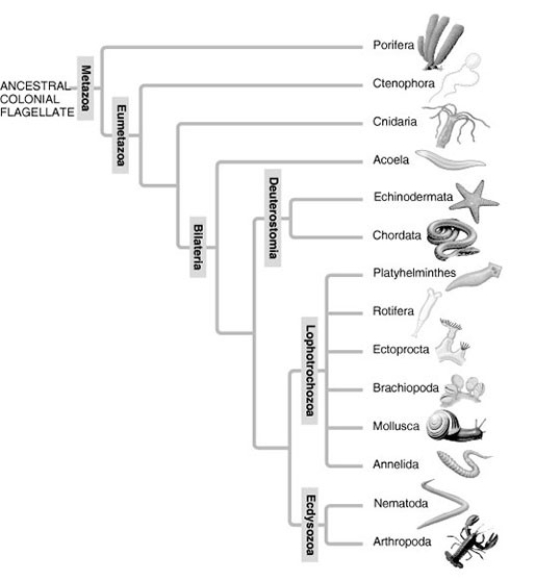
In the traditional phylogeny (A), the phylum Platyhelminthes is depicted as a sister taxon to the rest of the protostome phyla and as having diverged earlier from the lineage that led to the rest of the protostomes. In the molecular phylogeny (B), Platyhelminthes is depicted as a Lophotrochozoan phylum. What probably led to this change?
A) Platyhelminthes ceased to be recognized as true protostomes.
B) The removal of the acoel flatworms (Acoela) from the Platyhelminthes allowed the remaining flatworms to be a monophyletic clade clearly tied to the Lophotrochozoa.
C) All Platyhelminthes must have a well-developed lophophore as their feeding apparatus.
D) Platyhelminthes' close genetic ties to the arthropods became clear as their Hox gene sequences were studied.
A: Morphological phylogeny.

B: Molecular phylogeny.

In the traditional phylogeny (A), the phylum Platyhelminthes is depicted as a sister taxon to the rest of the protostome phyla and as having diverged earlier from the lineage that led to the rest of the protostomes. In the molecular phylogeny (B), Platyhelminthes is depicted as a Lophotrochozoan phylum. What probably led to this change?
A) Platyhelminthes ceased to be recognized as true protostomes.
B) The removal of the acoel flatworms (Acoela) from the Platyhelminthes allowed the remaining flatworms to be a monophyletic clade clearly tied to the Lophotrochozoa.
C) All Platyhelminthes must have a well-developed lophophore as their feeding apparatus.
D) Platyhelminthes' close genetic ties to the arthropods became clear as their Hox gene sequences were studied.

Unlock Deck
Unlock for access to all 67 flashcards in this deck.
Unlock Deck
k this deck
54
When a scientist describes the "body plan" of a phylum, he or she is implying that ________.
A) organisms direct their own evolution in order to maximize their success
B) animals evolve according to a pre-ordained plan
C) the body shapes we see now have been more successful than others in the past
D) mutations have arisen that allow only some shapes to be produced
A) organisms direct their own evolution in order to maximize their success
B) animals evolve according to a pre-ordained plan
C) the body shapes we see now have been more successful than others in the past
D) mutations have arisen that allow only some shapes to be produced

Unlock Deck
Unlock for access to all 67 flashcards in this deck.
Unlock Deck
k this deck
55
Use the figure to answer the question.
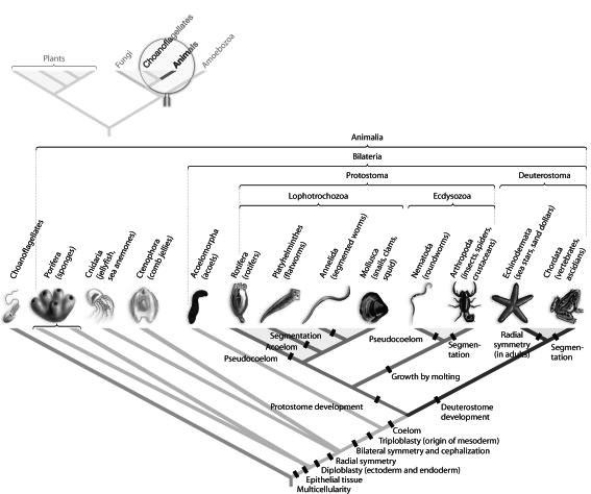
Which of the following statements is supported by the phylogeny in the figure?
A) Deuterostoma are more evolutionarily advanced than Porifera.
B) Traits, once they evolve, are retained in later-evolving taxonomic groups.
C) Animals show no evidence of convergent evolution in their traits.
D) Animals with extremely different adult forms can be relatively closely related.

Which of the following statements is supported by the phylogeny in the figure?
A) Deuterostoma are more evolutionarily advanced than Porifera.
B) Traits, once they evolve, are retained in later-evolving taxonomic groups.
C) Animals show no evidence of convergent evolution in their traits.
D) Animals with extremely different adult forms can be relatively closely related.

Unlock Deck
Unlock for access to all 67 flashcards in this deck.
Unlock Deck
k this deck
56
Nine-banded armadillos give birth to four offspring at a time. An amazing fact about these offspring is that they are genetically identical to each other. This fact suggests ________.
A) the young undergo metamorphosis
B) the embryo undergoes radial and indeterminate cleavage
C) the first cell division of the fertilized egg is perpendicular to the vertical axis of the egg
D) the species is pseudocoelomate
A) the young undergo metamorphosis
B) the embryo undergoes radial and indeterminate cleavage
C) the first cell division of the fertilized egg is perpendicular to the vertical axis of the egg
D) the species is pseudocoelomate

Unlock Deck
Unlock for access to all 67 flashcards in this deck.
Unlock Deck
k this deck
57
In the future, phylogenetic studies should be conducted to ________.
A) resolve the branching patterns (evolutionary history) of the Lophotrochozoa
B) discover the Hox genes in sponges
C) discover the relationships between nematodes and platyhelminthes
D) discover the larval stages of echinoderms
A) resolve the branching patterns (evolutionary history) of the Lophotrochozoa
B) discover the Hox genes in sponges
C) discover the relationships between nematodes and platyhelminthes
D) discover the larval stages of echinoderms

Unlock Deck
Unlock for access to all 67 flashcards in this deck.
Unlock Deck
k this deck
58
Use the figure to answer the question.
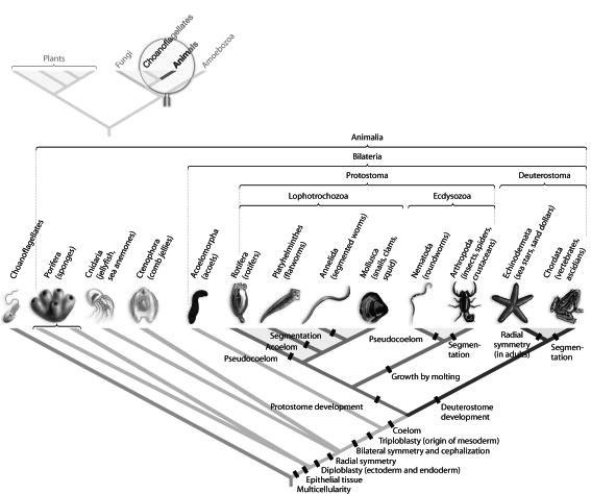
Which morphological trait evolved more than once in animals, according to the phylogeny based on DNA sequence data found in the figure?
A) coelom
B) bilateral symmetry
C) segmentation
D) protostome development

Which morphological trait evolved more than once in animals, according to the phylogeny based on DNA sequence data found in the figure?
A) coelom
B) bilateral symmetry
C) segmentation
D) protostome development

Unlock Deck
Unlock for access to all 67 flashcards in this deck.
Unlock Deck
k this deck
59
Use the table to answer the question.
Proposed Number of Hox Genes in Various Extant and Extinct Animals

What conclusion can best be drawn from the data in the table?
A) Land animals have more Hox genes than do those that live in water.
B) All bilaterian phyla have had the same degree of expansion in their numbers of Hox genes.
C) The expansion in number of Hox genes throughout vertebrate evolution cannot be explained merely by three duplications of the ancestral vertebrate Hox cluster.
D) Extant insects all have seven Hox genes.
Proposed Number of Hox Genes in Various Extant and Extinct Animals

What conclusion can best be drawn from the data in the table?
A) Land animals have more Hox genes than do those that live in water.
B) All bilaterian phyla have had the same degree of expansion in their numbers of Hox genes.
C) The expansion in number of Hox genes throughout vertebrate evolution cannot be explained merely by three duplications of the ancestral vertebrate Hox cluster.
D) Extant insects all have seven Hox genes.

Unlock Deck
Unlock for access to all 67 flashcards in this deck.
Unlock Deck
k this deck
60
The last common ancestor of all bilaterians is thought to have had four Hox genes. Most extant cnidarians have two Hox genes, though some have three Hox genes. On the basis of these observations, some have proposed that the ancestral cnidarian's were originally bilateral and, in stages, lost Hox genes from their genomes. If true, this would mean that ________.
A) all radially symmetric animals should be grouped together in one clade
B) the radial symmetry of extant cnidarians is secondarily derived, rather than being an ancestral trait
C) Hox genes play little actual role in coding for an animal's "body plan"
D) cnidaria may someday replace porifera as the basal bilaterians
A) all radially symmetric animals should be grouped together in one clade
B) the radial symmetry of extant cnidarians is secondarily derived, rather than being an ancestral trait
C) Hox genes play little actual role in coding for an animal's "body plan"
D) cnidaria may someday replace porifera as the basal bilaterians

Unlock Deck
Unlock for access to all 67 flashcards in this deck.
Unlock Deck
k this deck
61
One of the characteristics unique to animals is
A) gastrulation.
B) multicellularity.
C) sexual reproduction.
D) flagellated sperm.
A) gastrulation.
B) multicellularity.
C) sexual reproduction.
D) flagellated sperm.

Unlock Deck
Unlock for access to all 67 flashcards in this deck.
Unlock Deck
k this deck
62
Placing sponges as the basal metazoans on the basis of lack of tissues implies which of the following?
A) Sponge ancestors never had tissues.
B) Modern-day sponges have lost the ability to form tissues.
C) Multicellular, modern-day choanoflagellates can form tissues.
D) Sponges do not have nerve cells.
A) Sponge ancestors never had tissues.
B) Modern-day sponges have lost the ability to form tissues.
C) Multicellular, modern-day choanoflagellates can form tissues.
D) Sponges do not have nerve cells.

Unlock Deck
Unlock for access to all 67 flashcards in this deck.
Unlock Deck
k this deck
63
The distinction between sponges and other animal phyla is based mainly on the absence versus the presence of
A) a body cavity.
B) a complete digestive tract.
C) mesoderm.
D) tissues.
A) a body cavity.
B) a complete digestive tract.
C) mesoderm.
D) tissues.

Unlock Deck
Unlock for access to all 67 flashcards in this deck.
Unlock Deck
k this deck
64
Which of the following was probably the least important factor in bringing about the Cambrian explosion?
A) the emergence of predator-prey relationships
B) an increase in the concentration of atmospheric oxygen
C) the movement of animals onto land
D) the origin of Hox genes
A) the emergence of predator-prey relationships
B) an increase in the concentration of atmospheric oxygen
C) the movement of animals onto land
D) the origin of Hox genes

Unlock Deck
Unlock for access to all 67 flashcards in this deck.
Unlock Deck
k this deck
65
Sponges and ctenophores have both been proposed as basal metazoans. Which of the following types of data support the idea that sponges are the basal group?
A) sequences of cadherin genes, cleavage type, structure of collar cells, and bilateral symmetry of adults
B) sequences of collagen genes, bilateral symmetry of adults, cleavage type, and fossil steroids
C) fossil steroids, molecular clock, lack of tissues in sponges, and structure of collar cells
D) structure of collar cells, bilateral symmetry of larvae, sequences of cadherin genes, and molecular clock
A) sequences of cadherin genes, cleavage type, structure of collar cells, and bilateral symmetry of adults
B) sequences of collagen genes, bilateral symmetry of adults, cleavage type, and fossil steroids
C) fossil steroids, molecular clock, lack of tissues in sponges, and structure of collar cells
D) structure of collar cells, bilateral symmetry of larvae, sequences of cadherin genes, and molecular clock

Unlock Deck
Unlock for access to all 67 flashcards in this deck.
Unlock Deck
k this deck
66
Sponges and ctenophores have both been proposed as basal metazoans. Imagine that you wanted to provide additional evidence to help resolve this question. Which of the following projects would be the best next step?
A) more extensive study of DNA sequences in the bilateria
B) ultrastructural (that is, electron microscope) comparisons of choanoflagellates and sperm cells from arthropods
C) measurements of molecular clocks from the Lophotrochozoa
D) more extensive studies of DNA sequences in both groups
A) more extensive study of DNA sequences in the bilateria
B) ultrastructural (that is, electron microscope) comparisons of choanoflagellates and sperm cells from arthropods
C) measurements of molecular clocks from the Lophotrochozoa
D) more extensive studies of DNA sequences in both groups

Unlock Deck
Unlock for access to all 67 flashcards in this deck.
Unlock Deck
k this deck
67
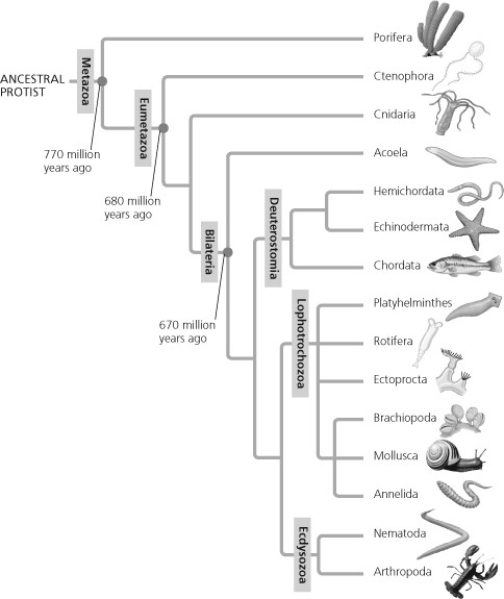
Based on the tree shown, which statement is false?
A) The animal kingdom is monophyletic.
B) Acoelomate flatworms are more closely related to echinoderms than to annelids.
C) Sponges are basal animals.
D) Bilaterians form a clade.

Unlock Deck
Unlock for access to all 67 flashcards in this deck.
Unlock Deck
k this deck



